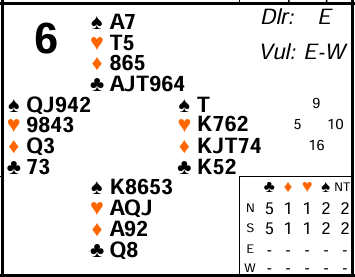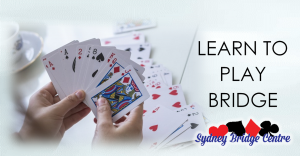City and Canada Bay – Thursday Morning 6th February 2025.

Board 6 last week contained a couple of useful bidding tips which would have enabled North South to reach 3NT, a contract which in practice is likely to make a lot (even though on this particular hand it could have been defeated).
Tip number 1 applies to South on this hand. When you have a balanced hand within your no-trump range, open it 1NT even if you have a 5 card major. It tends to make the auction so much simpler. If you don’t do that, then you need to worry about what you are going to rebid. Here suppose South does open 1♠. What will you rebid over a 2 level response from partner? Playing a strong no-trump, a 2NT rebid would typically show 12-14 so you are too good for that. But jumping to 3NT takes up a lot of space. Rebidding a poor spade suit is also not attractive. There just aren’t any good options. Opening 1NT with these sort of hands not only avoids those sort of rebid problems, it has other advantages too:
- It gives a good overall description of your hand type and strength to your partner – which means he is the only one at the table who truly knows which side’s hand it is.
- It makes it harder for the opponents to overcall (it’s risker for them to come in at the 2 level).
- Although occasionally you might miss a 5-3 spade fit, a proportion of the time 3NT will play just as well as, or even better than, 4♠ anyway!
There are ways of finding out about the 5 card spade suit if you wish. Some pairs choose to play 2♣ as a 5 card major ask instead of stayman; others have a further ask after 1NT P 2♣ P 2♠, etc. But overall it’s surprising how little difference it makes – after all the 5-3 fit can easily be a source of tricks in no-trumps and 9 tricks are often easier to make than 10!
With South having opened 1NT, tip number 2 applies to North. With a reasonable long minor suit, 3NT is a very reasonable gamble. Your hand could easily be worth 6 tricks in the minor and make 3NT quite easily (while 5 of a minor has 3 losers). On this hand you have a good 9 points opposite partner’s 15-17 so you should just immediately bid 3NT. If you were weaker it would be worth showing your long suit and then gambling 3NT if you find partner has the missing honour (see advanced section for more details on how you might do this). If you were stronger you might show your long suit as a possible move towards a slam.
You’ll see from the Deep Finesse analysis that 3NT doesn’t make. But it only goes off on a diamond lead. The defence can set up 4 diamond tricks and East will get in the ♣K to cash them. However, what would you lead as West? Leading the ♦Q from Qx is highly unlikely. West is much more likely to try a major suit (see advanced section for why). I’d lead ♠Q (quiz – how should you play 3NT after that lead? See advanced section for the answer).
When diamonds are not led, declarer can take a club finesse and even after it loses that sets up, as a minimum, 5 clubs to go with 2 spades and the two red aces. Of course that’s a bit lucky – swap the defenders diamonds around and West has an easy diamond lead. But a key point to remember in bridge is that opening leads are hard! Just because you can’t in theory make a contract doesn’t mean it’s not worth a try! Opponents don’t always do the right thing.
Key points to note
When you have a balanced hand within your no-trump range, open it 1NT even if you have a 5 card major. It tends to make the auction much simpler.
When partner opens 1NT and you have a reasonable long minor suit, 3NT is a very reasonable gamble.
Playing transfers to the minors over 1NT is useful – either to play in 3 minor with a very weak hand, or to enable you to find out if the suit is likely to run for 6 tricks with a slightly better hand (in which case 3NT is worth a try).
If the opponents bid 1NT 3NT tend to prefer a major suit lead (dummy almost certainly won’t have a major as he didn’t use stayman or a transfer so if you can hit the major declarer is weaker in, that’s likely to be the defence’s best start).
More advanced
It’s worth discussing how to handle hands with minor suits over 1NT. There are several methods available but, just like the majors, it’s useful for a weak hand to have a way of getting out into that suit via a transfer. A method I play is known as “four suit transfers” so, in addition to the normal major suit transfers, 2♠ is a transfer to clubs and 2NT is a transfer to diamonds (you don’t need 2NT to be invitational since those hands can all go via Stayman first). I have also seen 2♠ played as a transfer to either minor.
Minor suit transfers have an additional option because there’s an intervening step besides just completing the transfer (2NT over 2♠ and 3♣ over 2NT). So it’s also useful to have an agreement about what the difference is. Because 3NT is the contract you are most likely wanting to get to where possible, it’s handy for one of the two to be a “super-accept” showing support for the minor and the other to deny that holding (opinions vary which way round to play them!)
If partner does have support then you might be able to run the suit for lots of tricks. That’s the time you can then take a reasonable pot shot at 3NT – either hoping you have 9 tricks or that they will lead the wrong thing. But what sort of support? I like the super accept to show a top honour (A, K or Q in the suit). My regular partner and I play that this might only be a doubleton, the idea being if partner has a 6 card suit with the other top honours (e.g. AQxxxx) it’s more useful to know partner has the missing honour than how many because the chances of running 6 tricks in the suit are then very good. So we don’t super-accept on 3 or 4 small in the minor. But I know other pairs do, and I know other people also require at least Hxx. As usual, the most important thing is to have an agreement that you both know! Note that this is only worth doing with a weaker hand where you are only going to gamble 3NT if you find out partner has the missing honour. With a stronger hand (such as the one here) you should bid 3NT straight away – why bother to tell the opponents what long minor suit you have?!
I said that a major is more likely to be led against 3NT here. Why? Because after the auction 1NT 3NT, it’s highly likely that responder does not hold a major suit. If he did surely he would have used stayman or transfers to look for a major suit fit? Therefore a major suit lead becomes more attractive as it could easily also be declarer’s weak spot.
Finally, what about playing 3NT after ♠Q lead? It’s just a case of managing entries. You need to win the spade in hand with the ♠K and then play on clubs. Imagine if you won in dummy and later took a club finesse. East could duck his ♣K the first time. Then there is no entry to North’s long clubs. By keeping the ♠A in dummy you don’t really care whether the club finesse wins or loses as you have 2 spades, 2 red aces and either 5 or 6 clubs.
Julian Foster (many times NSW representative) ♣♦♥♠




